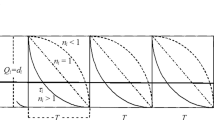Abstracts
We consider a single item (two different brands) inventory problem in which the demand of either of the two brands is generated by a transition probability matrix (p ij). The technique of Z transform Analysis for Markor Process, following Howard [1], [2] has been applied to determine, the multi step probabilities. The total expected profit per cycle of the system and the optimum stock levels at both the brands have been determined.
Similar content being viewed by others
References
Howard, Ronald A. (1960):Dynamic Programming and Markor Processes. The M. I. T. Press Cambridge.
Howard, Ronald A. (1971):Dynamic Probabilistic Systems, Volume I: Markor Models. John Wiley and Sons.
Arunachandran, Ravindran (1972): “Management of Seasonal Style Goods Inventories”.Operations Research, Vol. 20, No. 2 March–April 1972.
Magee, John F.: “Guides to Inventory Policy”.Harvard Business Review, 58–59, May–June 1956.
Author information
Authors and Affiliations
Rights and permissions
About this article
Cite this article
Gupta, R.D. Single commodity two brands discrete inventory model. Trabajos de Estadistica Y de Investigacion Operativa 29, 89–96 (1978). https://doi.org/10.1007/BF02888730
Issue Date:
DOI: https://doi.org/10.1007/BF02888730




